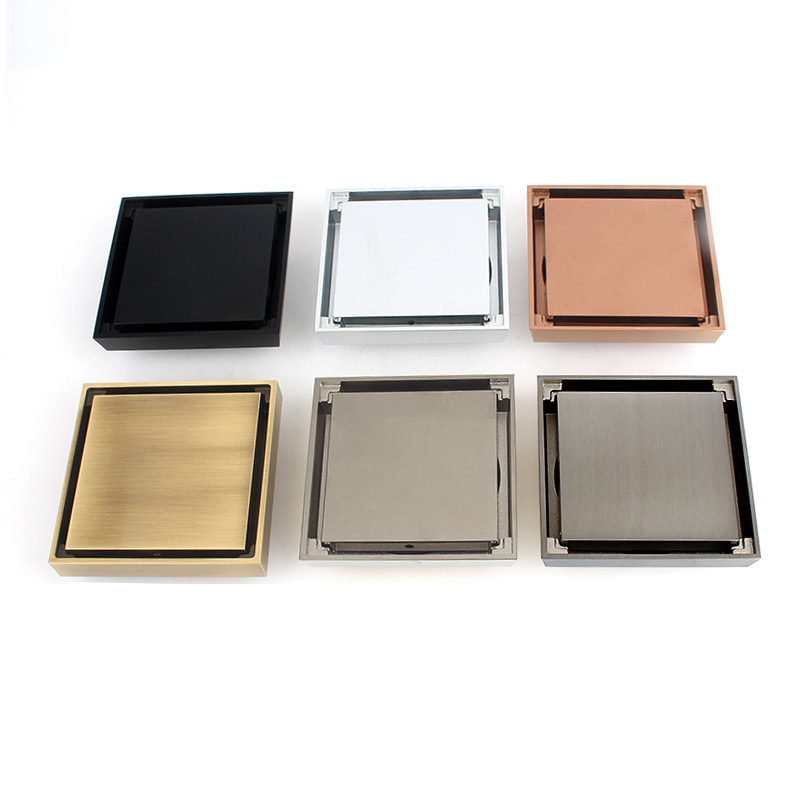What Size Is A Shower Drain?
When designing or renovating a bathroom, one detail that often gets overlooked is the size of the Shower Drain. It might seem like a minor element, but the drain’s diameter, shape, and design directly affect how efficiently water flows away, how easy it is to clean, and how the shower floor looks overall. Selecting the correct size ensures that the bathroom remains both functional and stylish for years.
This article provides an in-depth overview of what a shower drain is, the different types available, the most common size standards, and how various sizes are suited to different applications. By understanding how these dimensions work, you can choose a drain that perfectly fits your project requirements.
1. Understanding What a Shower Drain Is
A shower drain is the exit point through which water from your shower floor flows into the home’s plumbing system. It connects to the drainage pipe beneath the shower base and serves two critical purposes:
Efficiently removing wastewater from the shower area.
Preventing unpleasant odors from the sewer from rising back into the bathroom.
Most modern drains are made of corrosion-resistant materials such as 304 stainless steel, brass, or ABS plastic, designed to withstand moisture and cleaning agents. A well-built drain includes:
A grate or cover that filters out debris.
A drain body where water collects before entering the pipe.
A trap system that holds a small amount of water to block odors.
A connector or outlet that joins with the main plumbing network.
The combination of these components allows the shower to stay dry, sanitary, and long-lasting.
2. Types of Shower Drains by Design
Not all drains serve the same architectural purpose. Over time, manufacturers have developed different drain types to suit distinct bathroom layouts and aesthetic preferences.
Linear Drain
A linear drain is a long rectangular channel placed either at the center or along one edge of the shower floor. It is highly efficient in moving water quickly while maintaining a clean, modern appearance.
Typical lengths: 24, 27, 36, 48, and 60 inches.
Ideal for: Walk-in or barrier-free showers, large spa bathrooms, or minimalist interiors.
Benefits: Works with a single-direction slope, reducing grout cuts and simplifying tiling.
Square Drain
The square drain is the most familiar and traditional style. It is compact, symmetrical, and designed for smaller bathrooms.
Common sizes: 4 × 4 inches and 6 × 6 inches.
Ideal for: Standard residential bathrooms or small shower cabins.
Benefits: Easy to install, affordable, and fits directly over standard 2-inch or 3-inch drainpipes.
Slim Drain
A slim drain is a newer concept that features a low-profile design, making it perfect for areas where installation depth is limited.
Common sizes: 20–28 inches in length.
Ideal for: Renovations or apartments with thin subfloors.
Benefits: Minimalist look, lightweight, and suitable for quick installations.
Invisible (Tile-In) Drain
A tile-in drain integrates directly with the floor tiles, concealing the drainage system entirely while maintaining effective water removal.
Common sizes: 24–36 inches.
Ideal for: Luxury bathrooms and design-focused architecture.
Benefits: Blends seamlessly with the flooring, giving a unified surface finish.
Each type offers unique advantages depending on the space, layout, and design intent.
3. Standard Shower Drain Sizes and Measurements
Shower drains vary not only by shape but also by diameter, length, and depth. These dimensions determine the flow capacity and overall performance. The most widely used sizes in residential and commercial projects include:
| Type | Size Range | Material Options | Drain Opening Diameter | Common Thickness |
|---|---|---|---|---|
| Square Drain | 4–6 inches (100–150 mm) | 304 stainless steel, brass | 2–3 inches | 1.5–2.0 mm |
| Linear Drain | 24–60 inches (600–1500 mm) | 304/316 stainless steel | 2 inches | 2.0 mm |
| Slim Linear Drain | 20–28 inches (500–700 mm) | 304 stainless steel | 1.5–2 inches | 1.5 mm |
| Tile-In Drain | 24–36 inches (600–900 mm) | 304 stainless steel | 2 inches | 2.0 mm |
Example Specification:
A popular model is a 27-inch (690 mm) 304 stainless steel linear drain with a 2.0 mm thickness and brushed, polished, or PVD-treated surface. Available finishes include matte black, chrome, PVD gold, PVD grey, and rose gold, suitable for both modern residential and hotel projects.
Such measurements ensure reliable performance while aligning with international plumbing standards.
4. How Size Affects Performance and Installation
Choosing the correct shower drain size isn’t simply about looks — it impacts drainage speed, floor slope, and even daily maintenance.
1. Drainage Efficiency
Smaller 4-inch drains handle typical shower flow rates effectively for one showerhead.
Longer linear drains (24–60 inches) are better for rainfall showers, multiple nozzles, or high-flow systems.
For spa or gym applications, extra-wide drains maintain constant water clearance.
2. Floor Slope Compatibility
Square drains require a four-way slope toward the center, often used in small, enclosed showers.
Linear drains need just a single-direction slope, ideal for barrier-free walk-in designs.
3. Cleaning and Maintenance
A wider or longer drain allows for easier access to internal parts. Many stainless-steel models feature removable strainers or traps that simplify cleaning. Compact square drains may need more frequent maintenance to prevent hair and soap buildup.
4. Installation Depth
Slim or shallow drains are made for spaces with limited subfloor clearance. If your shower is part of a renovation project, a 20–28 inch slim linear drain with a low-profile body can fit perfectly without requiring a full rebuild of the floor.
5. Applications for Different Shower Drain Sizes
Each size and style suits specific building requirements. Below is a practical breakdown of where various drain sizes work best.
Small-Sized Drains (4–6 inches)
Usage: Compact bathrooms, apartments, and hotels.
Features: Quick to install, compatible with 2-inch outlets.
Advantages: Simple maintenance and easy replacement.
Considerations: Best for standard water pressure and smaller shower areas.
Medium Linear Drains (20–36 inches)
Usage: Modern homes and commercial bathrooms.
Features: Balanced length for aesthetics and functionality.
Advantages: Smooth drainage with high flow rate, available in various finishes.
Considerations: Ensure a proper slope and waterproofing for optimal results.
Long Linear Drains (48–60 inches)
Usage: Luxury bathrooms, spas, and open wet-room designs.
Features: Capable of handling heavy water loads.
Advantages: Ideal for rainfall showers or multiple water outlets.
Considerations: Requires professional installation and strong subfloor support.
Custom or Oversized Drains (72 inches and above)
Usage: Gyms, locker rooms, and hotel wellness centers.
Features: Multiple outlets and heavy-duty stainless-steel construction.
Advantages: Long-lasting and resistant to wear and corrosion.
Considerations: Typically used in commercial or industrial projects.
Selecting a drain that fits your environment ensures reliable water management and long-term durability.
6. How to Choose the Right Shower Drain Size
Selecting the best shower drain involves balancing practical performance with design aesthetics. Here’s how to make the right decision:
Measure the Shower Floor Area
Larger showers require longer drains or multiple outlets to maintain quick water removal.Consider Water Flow Rate
High-flow fixtures such as rainfall or massage jets demand drains with greater capacity.Evaluate the Installation Depth
For concrete subfloors or limited spaces, opt for slim or shallow models.Match the Style
Linear drains enhance minimalist and modern looks, while square drains blend with traditional layouts.Select Durable Materials
Always choose 304 or 316 stainless steel for corrosion resistance, especially in humid climates.Confirm Compliance with Plumbing Standards
Check that the outlet size matches your local building code — typically 2-inch or 3-inch connections.
A properly chosen drain not only performs better but also complements the overall design theme of the bathroom.
Conclusion
The size of a shower drain plays a central role in how efficiently your bathroom functions. Whether you choose a compact 4-inch square drain or an elegant 60-inch linear drain, each option offers distinct advantages based on layout, flow capacity, and visual preference.
Using high-quality materials like 304 stainless steel with finishes such as matte black, brushed nickel, chrome, or PVD gold ensures long-term resistance to corrosion while enhancing the bathroom’s aesthetics.
Ultimately, the right shower drain size bridges the gap between engineering precision and design harmony—keeping your bathroom both beautiful and perfectly functional.
Previous: How To Naturally Unclog A Shower Drain?




